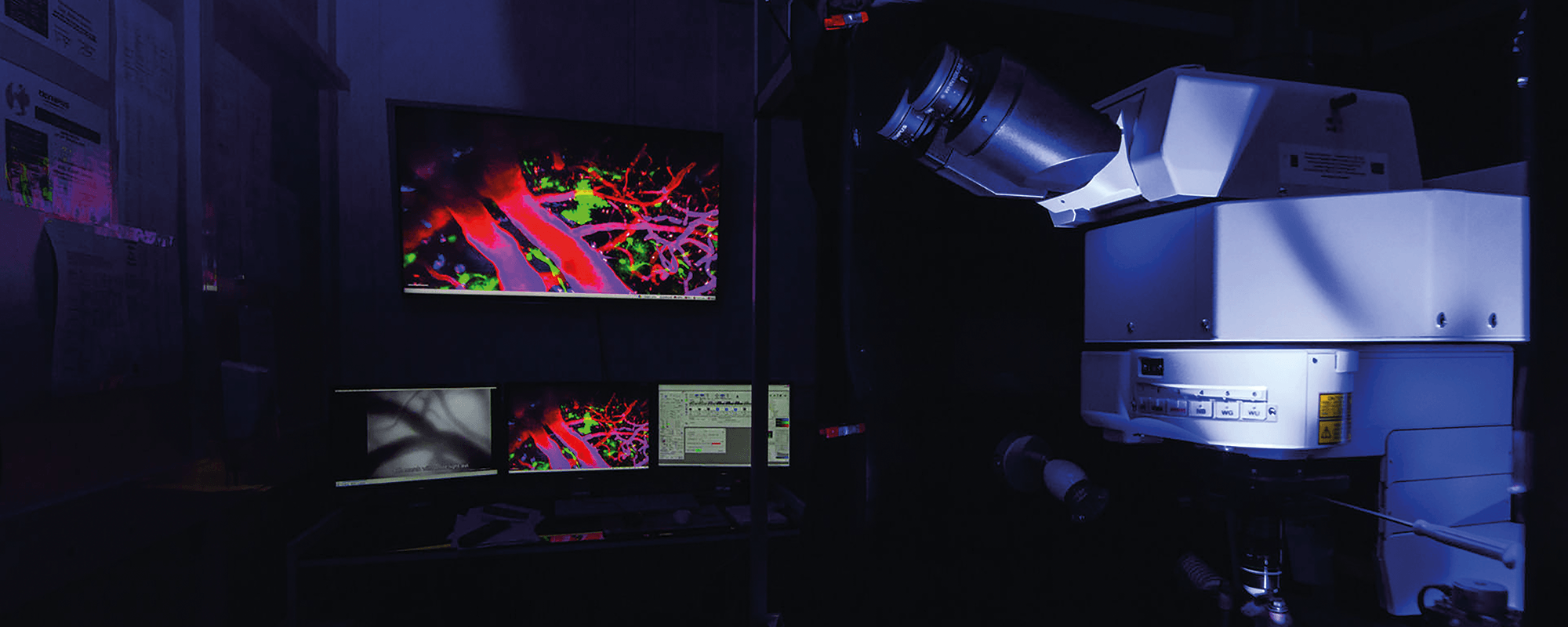A healing touch
Emerging research suggests that mild sensory stimulation like touch can protect the brain if delivered within the first two hours following a stroke. Laura Bonnici speaks with experimental stroke specialist Prof. Mario Valentino to find out how uncovering the secrets of this ‘touch’ may have life-changing implications for stroke patients worldwide.

Stroke is universally devastating. Often hitting like a bolt from the blue, it is the world’s third leading cause of death. In Malta, over 10% of the deaths recorded in 2011 were due to stroke. But stroke inflicts suffering not only through a loved one’s passing. As the most common cause of severe disability, stroke can instantly rob a person of their independence and dignity—even their very personality. This impact, individually, socially, and globally, makes stroke research a top priority.
Yet while scientists know the risk factors, signs, symptoms, and causes of both main types of stroke—whether ischemic, in which clots stop blood flow to the brain, or haemorrhagic, where blood leaks into the brain tissue from ruptured vessels—they have yet to find a concrete solution.
A dedicated team at the Faculty of Medicine (University of Malta) hopes to change that. Using highly sophisticated technology and advanced microscopic laser imaging techniques, Dr Jasmine Vella and Dr Christian Zammit, led by Prof. Mario Valentino, can follow what happens in a rodent’s brain as a stroke unfolds in real-time.
‘We use powerful lasers and very sensitive detectors coupled with special lenses, which allow us to capture the very fast events that unravel when a blood clot interrupts the blood supply in the brain,’ explains Valentino. ‘We observe what happens to the neighbouring blood vessels, nerve cells, and support cells, and the limb movements of the rodent throughout.’ Their aim is to find out how sensory stimulation might then help protect the brain.
The idea stems from an accidental discovery in 2010 by members of the Frostig Group at the University of Irvine, USA. The scientists found that when the whiskers of a rodent were stimulated within a critical time window following a stroke, its brain protected itself by permanently bypassing the blocked major artery that commonly causes stroke in humans. The brain’s cortical area is capable of extensive blood flow reorganisation when damaged, which can be brought about by sensory stimulation.
The human brain can bypass damage. For example, blind individuals have limited use of their visual cortex, so the auditory and somatosensory cortex expands, giving them heightened sensitivity to hearing and touch. For stroke patients, this means that the brain can compensate for its loss of function by boosting undamaged regions in response to light, touch, or sound stimulation.

‘This accidental discovery could be life-changing for stroke patients. The key is to figure out the mechanism involved in how sensory stimulation affects stroke patients, and then establish the best ways to activate that mechanism. Perhaps touching a stroke victim’s hands and face could have a similar beneficial effect, and this is what this latest research study hopes to define,’ says Valentino.
‘The team is now painstakingly correlating the data obtained during this brain imaging with the rodent’s movement and trajectory,’ he continues. ‘Using a motion-tracking device fitted under a sophisticated microscope, we can record the behaviour of the rodent during high-precision tactile stimulation, such as stroking their whiskers, and detect any gain of [brain] function through behavioural and locomotor readouts whilst ‘looking’ inside the brain in real-time.’
If they can prove that any protection is the direct cause of new blood vessels (or other cells) resulting from the electrical activity inspired by the sensory stimulation, then the next step would be to explore ways of redirecting these blood vessels to the affected brain area.
The team’s track record is encouraging. In collaboration with scientists from the University Peninsula Schools of Medicine and Dentistry, UK, they made another recent breakthrough that was published in Nature Communications, identifying a new drug, QNZ-46, that could protect the rodent brain following a stroke.
‘That project was about neuroprotective agents – to create a drug that will substantially block or reduce the injury, and so benefit a wider selection of patients,’ elaborates Valentino. ‘The study identified the source and activity of the neurotransmitter glutamate, which is the cause of the damage produced in stroke. This led to the discovery that QNZ-46 prevents some damage and protects against the toxic effects of the glutamate. This is potentially the first ever non-toxic drug that could prevent cell death during a stroke, and the results from this research could lead to pharmaceutical trials.’

While ongoing research in these projects has been supported through a €150,000 grant from The Alfred Mizzi Foundation through the RIDT, Valentino points out that globally-significant discoveries such as these are in constant need of support.
‘The funding of such projects is so important. This money is life-changing for people in such a predicament. Health research changes everything—our lifestyle, our quality of life, our longevity. And yet, government funding for research is still lacking. It’s only thanks to private companies and the RIDT, who realise the global potential of our work, that these projects can continue to try to change the lives of people all over the world,’ says Valentino.
And while Malta may be a small country with limited resources, the work conducted within its shores is reaching millions globally, proving that when it comes to knowledge, every contribution counts. We must continue striving for more to leave our best mark on the world.
Help us fund more projects like this, as well as research in all the faculties, by donating to RIDT.
Link: researchtrustmalta.eu/support-research/?#donations
Taking solar to sea
In a world first, a small team of engineers at the University of Malta is attempting to prove that harnessing solar power in the open sea is theoretically possible and cost-effective. Laura Bonnici speaks to Prof. Luciano Mulѐ Stagno to learn more about the ground-breaking Solaqua 2.1 project.
Renewable energy is in the spotlight. In Malta—an island that is said to enjoy an average of 300 days of sunshine per year—solar power has become mainstream, enabling the country to reach its goal of using 10% renewable energy by 2020.
But any advantage Malta has in terms of abundant sunshine, it loses through its lack of another vital resource: space. Measuring just 316 km², Malta’s limited surface area means that, beyond the existing photovoltaic (PV) panels installed on rooftops or disused quarries, any land left for larger PV installations is rare and expensive.

Prof. Luciano Mulѐ Stagno at the University of Malta believes the answer to this problem lies not on land, but at sea. Malta being surrounded by water, he has proposed that installing solar panels in open water, in offshore floating PV farms, could be as cost-effective and reliable as those on land—an idea that has never progressed beyond the theoretical stage anywhere in the world.
‘There are many PV projects happening on fresh water everywhere, from China and the UK to France and USA. But none of them are working on open sea,’ explains Mulѐ Stagno. ‘Their PV farms are installed in more sheltered, land-locked waters such as irrigation ponds or lakes, believing that PV farms cannot survive sea conditions. The Solaqua project aims to prove that they can survive, and do so at a comparable cost to land-based PV farms.’
When funding was secured from MCST in 2012, the previous Solaqua 1.0 project set about achieving these ambitious aims. Testing various prototypes out at sea, it confirmed that large, floating platforms were viable, cheap to construct, and could produce more power than similar systems on land.
The sea proved beneficial for many reasons. ‘The offshore panels produced around 3% more energy than similar land-based modules simply by being at sea, possibly due to the cooler temperatures at sea and a less dusty environment.’
The success of the first project inspired a second. With this one, the modular raft was designed and tested. ‘Solaqua 2.0 was financed by Takeoff [The University of Malta’s business incubator] in July 2017, with a preliminary design for the platform almost completed. Now discussions are underway about possible patents for the design,’ Mulѐ Stagno elaborates. ‘The ultimate aim is to launch a large farm in Maltese territorial water which, if it meets

the cost and power output targets, will be followed by other systems worldwide.’
The Professor and his team (marine structural engineer Dr Federica Strati, systems engineer Ing. Ryan Bugeja, and engineer Martin Grech) are now starting the next phase of the Solaqua project. Before the team builds and launches a full-scale system, they have to conduct a series of rigorous wave tank tests. Using a scale model while mimicking the worst possible sea conditions that the system may encounter, the team will be able to refine the design and optimise power output by testing the effect of water motion, cooling, or even different types of panels.
‘Through Solaqua 2.1, we hope to reassure investors that the system is viable. Once completed, we will be ready to launch a full-scale system that could be used not only by islands such as Malta, but also in coastal cities around the world which have insufficient land available for PV systems.’
Investors are being invited to join this project to push for global commercialisation. To reach this stage, several local entities supported the project. The Regulator for Energy and Water Services, with the help of the RIDT (the University of Malta’s Research Trust), invested €100,000 to cover the cost of constructing the scale model, as well as testing, equipment, transport, and engineers. And now that the project is commanding international interest, potential investors are being sought for the half a million euros needed to achieve a full-scale floating solar farm in Maltese waters.
‘This is a homegrown project, in which Malta could be an example to the world,’ explains Mulѐ Stagno. ‘We have already placed Malta at the cutting edge of this research area by being the first to test small systems in the open sea. Now we need to find an investor willing to take the plunge and help us create the world’s first full-scale floating solar farm. With Solaqua, Malta could be at the forefront of a ground-breaking new global industry—one which has the potential to change the way solar power is collected and used the world over.’



